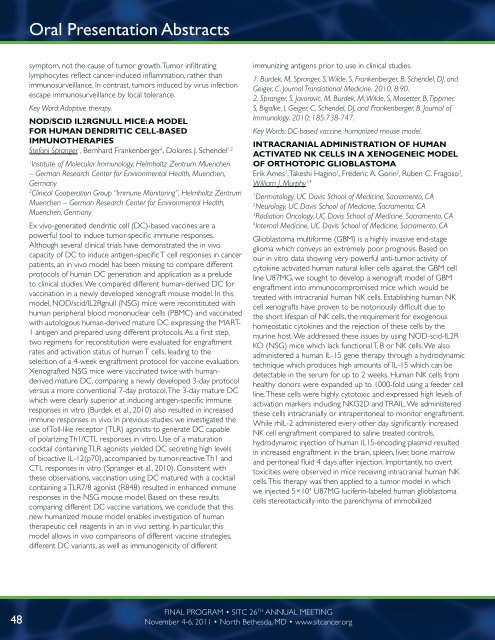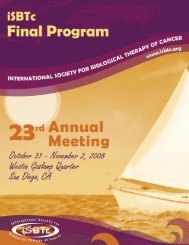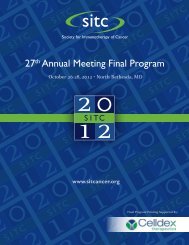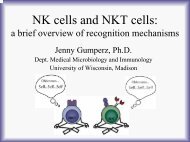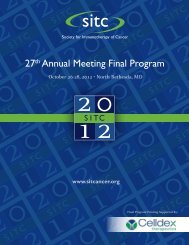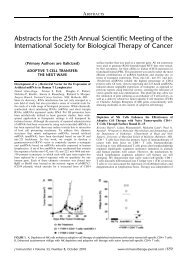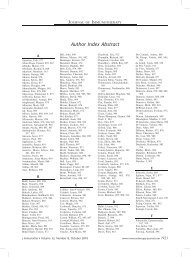FINAL PROGRAM - Society for Immunotherapy of Cancer
FINAL PROGRAM - Society for Immunotherapy of Cancer
FINAL PROGRAM - Society for Immunotherapy of Cancer
You also want an ePaper? Increase the reach of your titles
YUMPU automatically turns print PDFs into web optimized ePapers that Google loves.
Oral Presentation Abstracts<br />
symptom, not the cause <strong>of</strong> tumor growth. Tumor infiltrating<br />
lymphocytes reflect cancer-induced inflammation, rather than<br />
immunosurveillance. In contrast, tumors induced by virus infection<br />
escape immunosurveillance by local tolerance.<br />
Key Word: Adoptive therapy.<br />
NOD/SCID IL2RGNULL MICE: A MODEL<br />
FOR HUMAN DENDRITIC CELL-BASED<br />
IMMUNOTHERAPIES<br />
Stefani Spranger 1 , Bernhard Frankenberger 1 , Dolores J. Schendel 1,2<br />
1<br />
Institute <strong>of</strong> Molecular Immunology, Helmholtz Zentrum Muenchen<br />
– German Research Center <strong>for</strong> Environmental Health, Muenchen,<br />
Germany<br />
2<br />
Clinical Cooperation Group “Immune Monitoring”, Helmholtz Zentrum<br />
Muenchen – German Research Center <strong>for</strong> Environmental Health,<br />
Muenchen, Germany<br />
Ex vivo-generated dendritic cell (DC)-based vaccines are a<br />
powerful tool to induce tumor-specific immune responses.<br />
Although several clinical trials have demonstrated the in vivo<br />
capacity <strong>of</strong> DC to induce antigen-specific T cell responses in cancer<br />
patients, an in vivo model has been missing to compare different<br />
protocols <strong>of</strong> human DC generation and application as a prelude<br />
to clinical studies. We compared different human-derived DC <strong>for</strong><br />
vaccination in a newly developed xenograft mouse model. In this<br />
model, NOD/scid/IL2Rgnull (NSG) mice were reconstituted with<br />
human peripheral blood mononuclear cells (PBMC) and vaccinated<br />
with autologous human-derived mature DC expressing the MART-<br />
1 antigen and prepared using different protocols. As a first step,<br />
two regimens <strong>for</strong> reconstitution were evaluated <strong>for</strong> engraftment<br />
rates and activation status <strong>of</strong> human T cells, leading to the<br />
selection <strong>of</strong> a 4-week engraftment protocol <strong>for</strong> vaccine evaluation.<br />
Xenografted NSG mice were vaccinated twice with humanderived<br />
mature DC, comparing a newly developed 3-day protocol<br />
versus a more conventional 7-day protocol. The 3-day mature DC<br />
which were clearly superior at inducing antigen-specific immune<br />
responses in vitro (Burdek et al., 2010) also resulted in increased<br />
immune responses in vivo. In previous studies we investigated the<br />
use <strong>of</strong> Toll-like receptor (TLR) agonists to generate DC capable<br />
<strong>of</strong> polarizing Th1/CTL responses in vitro. Use <strong>of</strong> a maturation<br />
cocktail containing TLR agonists yielded DC secreting high levels<br />
<strong>of</strong> bioactive IL-12(p70), accompanied by tumor-reactive Th1 and<br />
CTL responses in vitro (Spranger et al., 2010). Consistent with<br />
these observations, vaccination using DC matured with a cocktail<br />
containing a TLR7/8 agonist (R848) resulted in enhanced immune<br />
responses in the NSG mouse model. Based on these results<br />
comparing different DC vaccine variations, we conclude that this<br />
new humanized mouse model enables investigation <strong>of</strong> human<br />
therapeutic cell reagents in an in vivo setting. In particular, this<br />
model allows in vivo comparisons <strong>of</strong> different vaccine strategies,<br />
different DC variants, as well as immunogenicity <strong>of</strong> different<br />
immunizing antigens prior to use in clinical studies.<br />
1. Burdek, M, Spranger, S, Wilde, S, Frankenberger, B, Schendel, DJ, and<br />
Geiger, C. Journal Translational Medicine. 2010; 8:90.<br />
2. Spranger, S, Javorovic, M, Burdek, M, Wilde, S, Mosetter, B, Tippmer,<br />
S, Bigalke, I, Geiger, C, Schendel, DJ, and Frankenberger, B. Journal <strong>of</strong><br />
Immunology. 2010; 185:738-747.<br />
Key Words: DC-based vaccine, humanized mouse model.<br />
INTRACRANIAL ADMINISTRATION OF HUMAN<br />
ACTIVATED NK CELLS IN A XENOGENEIC MODEL<br />
OF ORTHOTOPIC GLIOBLASTOMA<br />
Erik Ames 1 , Takeshi Hagino 1 , Frederic A. Gorin 2 , Ruben C. Fragoso 3 ,<br />
William J. Murphy 1,4<br />
1<br />
Dermatology, UC Davis School <strong>of</strong> Medicine, Sacramento, CA<br />
2<br />
Neurology, UC Davis School <strong>of</strong> Medicine, Sacramento, CA<br />
3<br />
Radiation Oncology, UC Davis School <strong>of</strong> Medicine, Sacramento, CA<br />
4<br />
Internal Medicine, UC Davis School <strong>of</strong> Medicine, Sacramento, CA<br />
Glioblastoma multi<strong>for</strong>me (GBM) is a highly invasive end-stage<br />
glioma which conveys an extremely poor prognosis. Based on<br />
our in vitro data showing very powerful anti-tumor activity <strong>of</strong><br />
cytokine activated human natural killer cells against the GBM cell<br />
line U87MG, we sought to develop a xenograft model <strong>of</strong> GBM<br />
engraftment into immunocompromised mice which would be<br />
treated with intracranial human NK cells. Establishing human NK<br />
cell xenografts have proven to be notoriously difficult due to<br />
the short lifespan <strong>of</strong> NK cells, the requirement <strong>for</strong> exogenous<br />
homeostatic cytokines and the rejection <strong>of</strong> these cells by the<br />
murine host. We addressed these issues by using NOD-scid-IL2R<br />
KO (NSG) mice which lack functional T, B or NK cells. We also<br />
administered a human IL-15 gene therapy through a hydrodynamic<br />
technique which produces high amounts <strong>of</strong> IL-15 which can be<br />
detectable in the serum <strong>for</strong> up to 2 weeks. Human NK cells from<br />
healthy donors were expanded up to 1000-fold using a feeder cell<br />
line. These cells were highly cytotoxic and expressed high levels <strong>of</strong><br />
activation markers including NKG2D and TRAIL. We administered<br />
these cells intracranially or intraperitoneal to monitor engraftment.<br />
While rhIL-2 administered every other day significantly increased<br />
NK cell engraftment compared to saline treated controls,<br />
hydrodynamic injection <strong>of</strong> human IL15-encoding plasmid resulted<br />
in increased engraftment in the brain, spleen, liver, bone marrow<br />
and peritoneal fluid 4 days after injection. Importantly, no overt<br />
toxicities were observed in mice receiving intracranial human NK<br />
cells. This therapy was then applied to a tumor model in which<br />
we injected 5×10 4 U87MG luciferin-labeled human glioblastoma<br />
cells stereotactically into the parenchyma <strong>of</strong> immobilized<br />
48<br />
<strong>FINAL</strong> <strong>PROGRAM</strong> • SITC 26 TH ANNUAL MEETING<br />
November 4-6, 2011 • North Bethesda, MD • www.sitcancer.org


